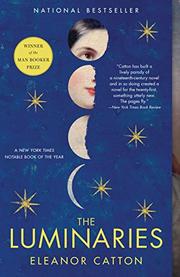
The Luminaries
The first thing you notice about The Luminaries is
physical: its massiveness. A long and daunting read, at 832 pages, you know
when you crack it open the first time that you will be holding it for a long
time. It is heavy at 2lbs 10oz (yes, I weighed it), a significant feature for small hands and
sore shoulders. The corners are sharp too.
By now you are saying, "Well, I’ll just download it onto my e-reader", which may work for you if your reader has more features than mine. Let me just say that I frequently needed to page back to check on dates, conversations and the long list of characters at the very beginning of the book. Is there an e-reader out there where you can use multiple bookmarks to move easily back and forth in the text?
By now you are saying, "Well, I’ll just download it onto my e-reader", which may work for you if your reader has more features than mine. Let me just say that I frequently needed to page back to check on dates, conversations and the long list of characters at the very beginning of the book. Is there an e-reader out there where you can use multiple bookmarks to move easily back and forth in the text?
Now for the story itself.
The Luminaries is set in New Zealand in the mid-19th
century, during the gold rush on the remote west coast of the South Island in the
dusty seaport of Hokitika, a town you can still visit today. The novel opens in
the middle of the story with a meeting of twelve characters who are meeting to
try to make sense of what has preceded that date of January 27, 1866.
The narration of the story comes in the voices of these twelve
characters and is told through their interactions and conversations with each other
and with eight other more minor characters. It becomes a problem to remember
who has said what to whom and when. Luckily, as we page through the story, some
of these details are repeated. It is
here that I should tell you that the 12 main characters represent the stars with the eight others as planetary characters and together they represent the astrological zodiac.
From that meeting, the story proceeds forward at a
snail’s pace and the mystery of what has happened so far starts to unravel and
open itself to our understanding. 832 pages further on, I’m not sure I care
anymore. This is a verrrry long novel.
Eleanor Catton, the author, 28 years old when the novel
was published in 2013, is an accomplished writer. The novel she has written is
Victorian in era, details and devices. Each chapter begins with a summary of
its content: “In which….” Each of the
twelve Parts is prefaced with an astrological chart.There are prostitutes, whore houses, opium dens, corseted
dresses, calling cards, Victorian morals and biases, séances and
fortune-telling, gold panning, fortune hunting and, most importantly, wealth,
found, misplaced and lost. Contemporary slang and Victorian ways of conveying
swear words (“d—ned”) add to the Dickensian feel of the novel.
For local flavour there are ships, shipwrecks, docks, gold flakes, nuggets and diggers, business men, Chinamen and Maoris.
Each Part (12 altogether) of the novel is exactly half the length of the previous
Part. At the end of the novel, then,
each Part and chapter rocks along more quickly and the introduction to each
chapter begins to hold more information than the chapter itself. I wonder how
difficult it must have been to write with such a rigorous structure in
mind. And in the end,
what difference does it make? Is that device tied in with the astrological
casting and symbology? In addition, the cover of the book serves as an
introduction to the astrological significance of the tale, with 12 diminishing
(waning) circles.
I probably need someone to explain the significance
of the astrology in the novel because I feel like I might be missing something that is
possibly very clever. On the other hand, as I think more about the cast of
characters, and recheck that list at the beginning of the book, it starts
to make some sense. The characters intersect and progress, as people, signs of the zodiac, stars and
planets align and pass through each others spheres. What a person does or says has reverberations in another
person’s life, not necessarily right away, but eventually. We are all
interconnected in a web of life. And what a puzzle it is!
The plot of this book is impossibly intricate. I found
myself wondering, as I was reading, how the author dreamed all these
details up and managed to shuffle them among the characters so well. Truly
amazing.
Catton is a deft story-teller and it’s easy to admire the
precision with which all the story lines intersect. But at the end, with the
diminishing word count quickly becoming difficult to achieve, the story itself
tapers off into nothingness.
Would I recommend this novel? I’d like to. It won the 2013 Man Booker Prize as well as Canada's Governor General’s Award and it’s definitely a
wonderful feat of writing and extremely clever. I think it would be a great addition to an English
course reading list and I know some very interesting discussions would ensue.
But I really like my friends and family and I’m afraid that recommending this
book might burden them terribly. I’m glad I read it, but there I leave it.
P.S. If, in spite of this indecisive review, you still want
to read The Luminaries, I have a copy. Also, here's a short video of Eleanor Catton reading from the novel and making a few comments.
No comments:
Post a Comment